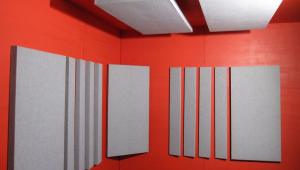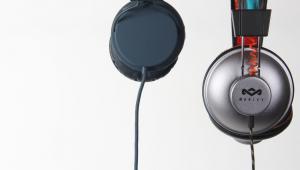Upcoming A16 uses your existing headphones to emulate up to 16 surround speakers with full headtracking horizontally & vertically. You have heard nothing until you've heard the A16
3D Sound Labs One Module: VR Audio from Your Current Cans?

The 3D Sound Labs One Module setup is really straightforward. About the size of 2 AA batteries next to one another, the module straps to your headphone’s headband, and connects with your media device via Bluetooth. There is an app, called One Player, for iOS devices as well as a beta for Windows 8.1 and 10. Here’s the catch: any media that you play back has to be uploaded to the One Player App. So every track of music, and every video had to be hand placed into the app’s library.
The file migration process is a bit tedious, especially if you want to listen to a lengthy playlist of music. But the process is simple enough, and seemingly only needs to be completed once. I moved over a short video that I had filmed, a movie clip, and several tracks of music to see what the experience was like. (360º Bowie? Yes, please.)
On their site, 3D sound labs says “3D Sound One reproduces the experience you would get from a speaker setup in your living room, in a pair of headphones you can take anywhere.” This claim is… true. Listening to any of the media I had, as well as the demos that accompany the app was akin to sitting in front of a pair of small desktop speakers and swiveling in an office chair. If I looked right, the stereo sound was louder in my left ear, turn left, and and vice versa. So, it worked, but it was a wall of sound rather than an immersive experience. Novel, I suppose, but not quite what I think most people are looking for in 3D listening.
Here is the inherent problem in personal 360º audio: for it to really work, it has to be mixed for headphones from the beginning, and be processed and decoded by one codec from beginning to end.
At CES 2016, Sennheiser announced their AMBEO technology, which encompasses recording, mixing, and playback of audio with spatial parameters. When I test drove the system in their booth last January, the results were pretty impressive. Because the audio is recorded at the same time as the 360 video, placement of sound is incredibly defined. While the short demo they presented featured a small room with someone speaking, it was interesting to hear room noises fixed in space as I moved my head, as well as turned my entire body.
But AMBEO and other such 3D audio tech require ground-up involvement from the beginning of the recording to the mixing, processing, and playback on your head. So unless performing artists, filmmakers, and game makers specifically design their media to be consumed in complete surround, the results are pretty underwhelming. “But!” I hear you say, “what about movies already mixed in surround? Dolby Atmos? DTS? Wouldn’t those films work in a headphone setup like this?”
Short answer? No. Not until each surround encoding system has a decoding app for playback designed for headphones. It’s not as simple as cut and paste. When a sound designer mixes the dinosaur growl to come from behind your head in a theater, it’s expected that there is a designated speaker placed in the room which will reproduce the noise. Headphones are limited to left and right, so the effect has to be more psychoacoustic than in a theater. This takes a lot of time and effort. It’s not impossible, but until the process is better streamlined by computer programs, it’s going to be somewhat costly. We’ll get there eventually, but it hasn’t happened just yet.
While there are video games already mixed in 3D for headphones, the sound placement doesn’t change with head movement, and so the experience still is somewhat lacking. VR gaming like Oculus Rift, for example, has 3D sound capabilities tied into their VR, but it isn’t being fully optimised consistently. Again, the success in execution largely depends on the game’s mix, not the system itself.
Take heart; we will get there. And if my small glimpses into the future with Sennheiser and Oculus are any indication, it will be amazing. But, until then, put your wallet away. We’re not there quite yet.
- Log in or register to post comments


I've been using Silicondust HDhomerun Dual, which is a 2 tuner network tuner for over 2 years- plugged in to my router, I can watch any channel from any device on my home network. The only thing this adds is WIFI and antenna. Silicondust now offers the HDhomerun Connect which comes with WIFI for $60, is the antenna worth almost $200 more?
























































